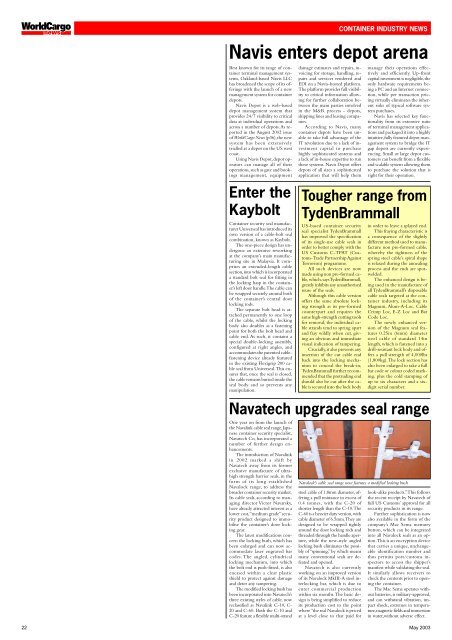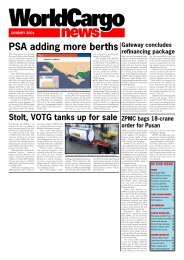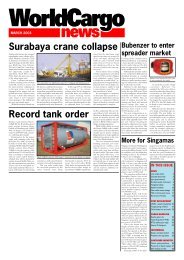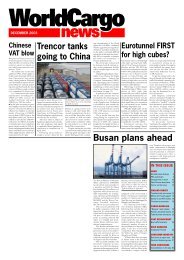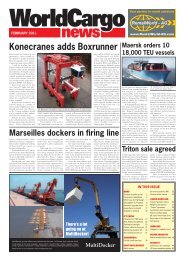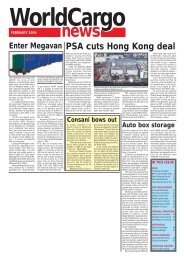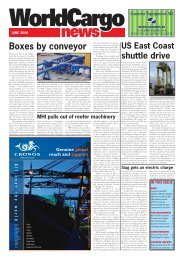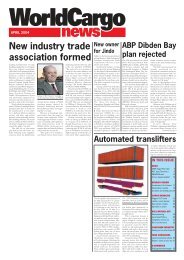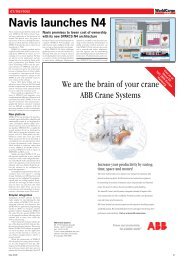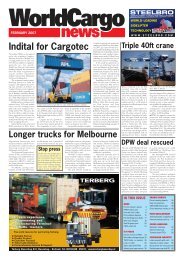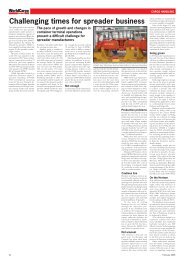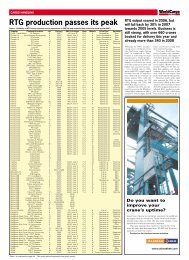Front Cover May - WorldCargo News Online
Front Cover May - WorldCargo News Online
Front Cover May - WorldCargo News Online
You also want an ePaper? Increase the reach of your titles
YUMPU automatically turns print PDFs into web optimized ePapers that Google loves.
<strong>WorldCargo</strong><br />
news<br />
22<br />
One year on from the launch of<br />
the Navalink cable seal range, Japanese<br />
container security specialist,<br />
Navatech Co, has incorporated a<br />
number of further design enhancements.<br />
The introduction of Navalink<br />
in 2002 marked a shift by<br />
Navatech away from its former<br />
exclusive manufacture of ultrahigh<br />
strength barrier seals, in the<br />
form of its long established<br />
Navalock range, to address the<br />
broader container security market.<br />
Its cable seals, according to managing<br />
director Victor Navarsky,<br />
have already attracted interest as a<br />
lower cost, “medium grade” security<br />
product designed to immobilise<br />
the container’s door locking<br />
gear.<br />
The latest modifications concern<br />
the locking bush, which has<br />
been enlarged and can now accommodate<br />
laser engraved bar<br />
codes. The angled, cylindrical<br />
locking mechanism, into which<br />
the bolt end is push-fitted, is also<br />
encased within a clear plastic<br />
shield to protect against damage<br />
and deter any tampering.<br />
The modified locking bush has<br />
been incorporated into Navatech’s<br />
three existing styles of cable, now<br />
reclassified as Navalink C-10, C-<br />
20 and C-60. Both the C-10 and<br />
C-20 feature a flexible multi-strand<br />
steel cable of 1.8mm diameter, offering<br />
a pull resistance in excess of<br />
0.4 tonnes, with the C-20 of<br />
shorter length than the C-10. The<br />
C-60 is a heavier duty version, with<br />
cable diameter of 6.5mm. They are<br />
designed to be wrapped tightly<br />
around the door locking rods and<br />
threaded through the handle aperture,<br />
while the new-style angled<br />
locking bush eliminates the possibly<br />
of “spinning,” by which means<br />
many conventional seals are defeated<br />
and opened.<br />
Navatech is also currently<br />
working on an improved version<br />
of its Navalock MkIII-A steel interlocking<br />
bar, which is due to<br />
enter commercial production<br />
within six months. The basic design<br />
is being simplified to reduce<br />
its production cost to the point<br />
where “the real Navalock is priced<br />
at a level close to that paid for<br />
CONTAINER INDUSTRY NEWS<br />
Navis enters depot arena<br />
Best known for its range of container<br />
terminal management systems,<br />
Oakland-based Navis LLC<br />
has broadened the scope of its offerings<br />
with the launch of a new<br />
management system for container<br />
depots.<br />
Navis Depot is a web-based<br />
depot management system that<br />
provides 24/7 visibility to critical<br />
data at individual operations and<br />
across a number of depots. As reported<br />
in the August 2002 issue<br />
of <strong>WorldCargo</strong> <strong>News</strong> (p36), the new<br />
system has been extensively<br />
trialled at a depot on the US west<br />
coast.<br />
Using Navis Depot, depot operators<br />
can manage all of their<br />
operations, such as gate and bookings<br />
management, equipment<br />
Enter the<br />
Kaybolt<br />
Container security seal manufacturer<br />
Universeal has introduced its<br />
own version of a cable-bolt seal<br />
combination, known as Kaybolt.<br />
The one-piece design has undergone<br />
an extensive reworking<br />
at the company’s main manufacturing<br />
site in Malaysia. It comprises<br />
an extended-length cable<br />
section, into which is incorporated<br />
a standard bolt seal for fitting in<br />
the locking hasp in the container’s<br />
left door handle. The cable can<br />
be wrapped securely around both<br />
of the container’s central door<br />
locking rods.<br />
The separate bolt head is attached<br />
permanently to one loop<br />
of the cable, whilst the locking<br />
body also doubles as a fastening<br />
point for both the bolt head and<br />
cable end. As such, it contains a<br />
special double-locking assembly,<br />
configured at right angles, and<br />
accommodates the patented cablefastening<br />
device already featured<br />
in the existing Flexigrip 200 cable<br />
seal from Universeal. This ensures<br />
that, once the seal is closed,<br />
the cable remains buried inside the<br />
seal body and so prevents any<br />
manipulation.<br />
damage estimates and repairs, invoicing<br />
for storage, handling, repairs<br />
and services rendered and<br />
EDI on a Navis-hosted platform.<br />
The platform provides full visibility<br />
to critical information allowing<br />
for further collaboration between<br />
the main parties involved<br />
in the M&R process - depots,<br />
shipping lines and leasing companies.<br />
According to Navis, many<br />
container depots have been unable<br />
to take full advantage of the<br />
IT revolution due to a lack of investment<br />
capital to purchase<br />
highly sophisticated systems and<br />
a lack of in-house expertise to run<br />
these systems. Navis Depot offers<br />
depots of all sizes a sophisticated<br />
application that will help them<br />
US-based container security<br />
seal specialist TydenBrammall<br />
has improved the specification<br />
of its single-use cable seals in<br />
order to better comply with the<br />
US Customs C-TPAT (Customs-Trade<br />
Partnership Against<br />
Terrorism) programme.<br />
All such devices are now<br />
made using non pre-formed cable,<br />
which, says TydenBrammall,<br />
greatly inhibits any unauthorised<br />
reuse of the seals.<br />
Although this cable version<br />
offers the same absolute locking<br />
strength as its pre-formed<br />
counterpart and requires the<br />
same high-strength cutting tools<br />
for removal, the individual cable<br />
strands tend to spring apart<br />
and fray wildly when cut, giving<br />
an obvious and immediate<br />
visual indication of tampering.<br />
Crucially, it also prevents any<br />
insertion of the cut cable end<br />
back into the locking mechanism<br />
to conceal the break-in,<br />
TydenBrammall further recommended<br />
that the protruding end<br />
should also be cut after the cable<br />
is secured into the lock body<br />
manage their operations effectively<br />
and efficiently. Up-front<br />
capital investment is negligible, the<br />
only hardware requirements being<br />
a PC and an Internet connection,<br />
while per transaction pricing<br />
virtually eliminates the inherent<br />
risks of typical software system<br />
purchases.<br />
Navis has selected key functionality<br />
from its extensive suite<br />
of terminal management applications<br />
and packaged it into a highly<br />
intuitive, fully featured depot management<br />
system to bridge the IT<br />
gap depots are currently experiencing.<br />
Small or large depot customers<br />
can benefit from a flexible<br />
and scalable system allowing them<br />
to purchase the solution that is<br />
right for their operation.<br />
Tougher range from<br />
TydenBrammall<br />
in order to leave a splayed end.<br />
This fraying characteristic is<br />
a consequence of the slightly<br />
different method used to manufacture<br />
non pre-formed cable,<br />
whereby the tightness of the<br />
spring steel cable’s spiral shape<br />
is relaxed during the annealing<br />
process and the ends are spotwelded.<br />
The enhanced design is being<br />
used in the manufacture of<br />
all TydenBrammall’s disposable<br />
cable seals targeted at the container<br />
industry, including its<br />
Magnum, Alum-A-Loc, Cable<br />
Crimp Loc, E-Z Loc and Bar<br />
Code Loc.<br />
The newly enhanced version<br />
of the Magnum seal features<br />
0.25in (6mm) diameter<br />
steel cable of standard 14in<br />
length, which is fastened into a<br />
drill-resistant lock body and offers<br />
a pull strength of 4,000lbs<br />
(1,800kg). The lock section has<br />
also been enlarged to take a full<br />
bar code or colour coded marking,<br />
plus the cold stamping of<br />
up to six characters and a sixdigit<br />
serial number.<br />
Navatech upgrades seal range<br />
Navalock’s cable seal range now features a modified locking bush<br />
look-alike products.” This follows<br />
the recent receipt by Navatech of<br />
full US Customs’ approval for all<br />
security products in its range.<br />
Further sophistication is now<br />
also available in the form of the<br />
company’s Mac Sema memory<br />
button, which can be integrated<br />
into all Navalock seals as an option.<br />
This is an encryption device<br />
that carries a unique, unchangeable<br />
identification number and<br />
thus permits port/customs inspectors<br />
to access the shipper’s<br />
manifest while validating the seal.<br />
It similarly allows receivers to<br />
check the contents prior to opening<br />
the container.<br />
The Mac Sema operates without<br />
batteries, is military-approved,<br />
and can withstand vibration, impact<br />
shock, extremes in temperature,<br />
magnetic fields and immersion<br />
in water,without adverse effect.<br />
<strong>May</strong> 2003


